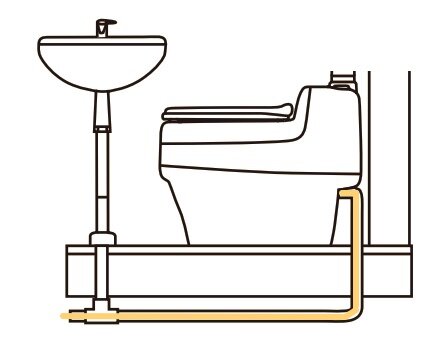
Our in-house compost toilet guru Martin, will help explain everything:
“Your strategy for dealing with any liquid outputs will depend on the type of toilet you have, the amount of use and local ground conditions. Remember check out national and region legislation – the information below is appropriate to the UK only and might be different elsewhere.”
We recommend checking with your local authority in case any restrictions are in place in your area, such as nitrate or phosphate-neutral zones (which might restrict the installation of any toilet, composting or flushing).
Also, check out our building regulations page for further information on compliance with building regulations and building control if applicable.
Kazuba toilets do not have any liquid discharge directly associated with them – depending on the model and amount of use, urine is typically evaporated or stored and pumped out when needed. The WooWoo GT toilet may have a small amount of leachate discharge, depending on the ambient temperature and amount of use. In many cases, this can be dealt with via a soak-away pit (see below), or leachate can be collected in a 10-litre container and disposed of in a suitable place, or diluted with water 10:1 for dispersal on land, around trees and shrubs.
Your first step should to estimate the amount of urine your toilet will be dealing with. This will be different for domestic and non-domestic settings. In a domestic setting, people might be away from the dwelling during the day, so you might only be dealing with evening or night use. If you’re planning a garden office, then the use will only be during working hours, and probably only 5 days a week.
Whilst it’s important to get a baseline figure, you also need to consider exceptional circumstances, so a domestic toilet might usually only have evening and weekend use, but potentially circumstances might change and the use could increase to ‘full time’,
The amount of urine a person will pass, per day, will be dependant on their fluid intake, but around 1.5 litres total per person per day is considered the average. Using this, you can now calculate a typical daily output.
The Environment Agency in England permits non-hazardous (urine) groundwater liquid discharges (ie discharging to the land via a soak-away pit or similar) of less than 10 litres per day under what is known as a ‘de-miminis’ exception. The guidelines recommend that the soak-away pit (point of discharge) is at least 10 metres away from a water course and 50 metres away from a source of potable water (well or borehole) although this can be varied depending on the amount of discharge expected and soil porosity.
Discharges to ground of more than 10 litres per day may require a permit.
The key consideration of any discharge is to ensure that urine (which contains nitrogen – a food source for plants) is kept away from water courses.
In Scotland, the Scottish Environment Protection Agency (SEPA) and in Wales, Natural Resources Wales/Cyfoeth Naturiol Cymru, may take a broadly similar approach as generally, discharges of under 10 litres per day are considered minimal, and therefore have no negative effect on the environment, but always check with the relevant authorities.
Any discharges, regardless of whether the Environment Agency, SEPA, or NRW deems them acceptable, should be done in a responsible manner that does not cause nuisance or damage to the wider environment or buildings contained thereon.

Due to the volume of liquid being relatively small (under 10 litres per day), the soak-away pit for urine doesn’t have to be very big.
For a ‘typical’ house with 4 occupants, a soak-away pit of around 50 x 50 x 50cm is adequate. Dig the hole, line it with a weed membrane to help slow soil movement, and fill with 10mm limestone or a suitable gravel etc. and run the urine pipe into the top of the pit.
It is suggested that limestone chippings will help balance the pH levels of fresh urine, although generally it’s not an issue to consider, so if you can’t get limestone, don’t worry.
Some building professionals may point you towards soakaway crates or a filter bed (aka infiltration bed), but they are really designed for larger runoffs and are not needed for the very small amount of urine that a urine-diverting toilet will create. However, ground conditions or usage may dictate that you need something larger.
The soak-away pit should ideally be dedicated to urine only and not shared with other outputs like sinks, showers, rainwater run off from roofs or other sources. Because the soakaway is only dealing with urine, there should be no odours coming back up the urine pipe, however, if you wish to fit a trap, you should consider installing an inline trap (such as a HEPVO trap) or a U bend in an accessible location in the urine pipe.
These are general guidelines, so adapt them to your local ground conditions accordingly – if you are concerned, you can conduct a ‘percolation’ test to measure how quickly your soil lets liquid pass through it, although the amount of urine is incredibly small and once in the ground will be very diluted so should not pose any risks or concerns. Use common sense and it should be fine.
Because the urine is being discharged underground, there will be no odours detected above ground, and microbes and bacteria will start to colonise the area and feed off the nutrients in the urine.
If you already have wastewater (aka greywater) pipework in your building, it might be possible to connect the urine output from the Separett compost toilet into that pipework.

Depending on your building and the layout of the pipes, this can be done above the floor, or below the floor as per the the diagram.
The fan within your Separett Villa or Tiny will remove most foul odours that might come up through the urine/greywater pipe. If you are concerned about possible odours, you can install a U bend or trap (such as a HEPVO inline trap) in an accessible position.
Users who are not permanently land-based (camper vans, boats, narrowboats etc) will need to opt for a toilet that temporarily holds the urine for a day or so. Both the Separett Tiny and Air Head have this option and provide a container of around 7.5 litres maximum capacity.
This should be ideally emptied daily and in a suitable location. Urine can usually be safely poured onto the earth around trees and shrubs, provided you don’t regularly empty it in the same place (which can result in urine salts building up) and not directly on foliage. Always ensure you have permission from the land owner to dispose of urine this way, and always do so in a responsible manner, well away from watercourses.
If you have access to an ‘elsan’ or chemical toilet disposal point, toilet or greywater drain, these are also ideal for emptying into.
Never pour urine into a canal or waterway – over time, it has the potential to promote excessive algal growth, which can lead to eutrophication (lack of oxygen) of the waterway.
Over time, urine can create deposits (calcification) within pipes which is why ideally you don’t want it laying in the pipe for any time. To counter this, ensure that all pipes that carry urine have a fall of at least 1 in 10. This way, urine should flow quickly along and through the pipe.
To keep pipes blockage free, rinse or spray the front urine bowl of your Separett compost toilet with a cup of water as often as you can remember to. Some people also find that adding some white vinegar to the spray or water will help.
Separett also make a special eco-friendly urinal block (called a ‘Bio Drain’ block) that you can place in the front part of the toilet bowl – each time someone urinates, a small amount of enzyme will be released which will help keep the pipes free from urine deposits.
We also have a blog post on ways of dealing with urine scaling in compost toilets.
Separett compost toilets are designed to be used year-round in all climates and are in use from Greenland to the Sahara Desert.
Provided you have at least a 1 in 10 fall in the urine pipe then freezing should not be an issue. Separett recommends that in exceptionally cold climates, it would be advisable to switch to 50mm waste pipe for the parts of the pipe that are outside, but in the UK that’s probably not necessary, even if your Separett is in use all year round, but it’s your choice.
The urine pipework supplied with your Separett Tiny or Villa has an outer diameter of 32mm and is semi-flexible. If you wish to run the urine through standard rigid pipework you will need an optional adaptor because rigid pipework sold in the UK tends to have an internal diameter of 32mm, but the external diameter will vary depending on whether you choose ‘push fit’ or ‘solvent weld’ pipes.
You can purchase a 32mm to 32mm compression adaptor from places like Screwfix or Toolstation (as well as many other plumbers merchants), which will fit onto either the straight or angled pipe connector that comes with your Separett Villa or Tiny. You can then fit 32mm push-fit or solvent weld pipe into the other side.
We’ve written a blog article which covers this in more detail.
Not sure which toilet is right for you, need a quote or want to know a little more information?
Help us advise you by telling us a little about your situation - or even better, give us a call to discuss options!
Alternatively, you can write us an email at:
or give us a call on:
Sign up to our newsletter to receive WooWoo news and offers
Like us on Facebook
Suppliers














